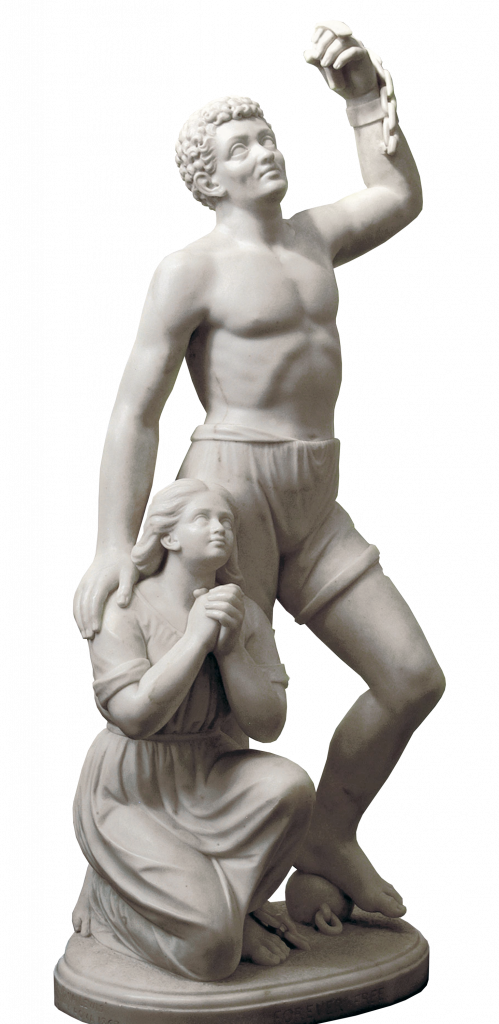
https://arthistoryproject.com/artists/mary-edmonia-lewis/forever-free/
Forever Free: A semi-nude, perfectly-proportioned man with curly hair lifts up his left arm, still shackled, but the chain broken; his left foot rests on a ball that was presumably once connected to that chain. His right arm rests on the shoulder of a woman, in a simple dress, with her lower arms bare and her hair open, who is kneeling by his side, her hands clasped in prayer. It is hard to see in this image, but on her left ankle, there is also a shackle with a broken chain. The heads of both figures are lifted upwards, with a strong suggestion that they are thanking God for their newly-won freedom from slavery. But maybe they are directly thanking Abraham Lincoln. The inscription on the base of the sculpture quotes directly from the Emancipation Proclamation:
“on the first day of January, in the year of our Lord one thousand eight hundred and sixty-three, all persons held as slaves within any State or designated part of a State, the people whereof shall then be in rebellion against the United States, shall be then, thenceforward, and forever free.”
As one of the first works of art to celebrate the emancipation of “all persons held as slaves,” Lewis’ 1867 sculpture, made just after she had settled in Rome, was often mentioned by art critics and journalists at the time, as was its presentation to noted Black abolitionist Reverend Leonard Grimes (1815-1873) at the Baptist Tremont Temple church in Boston in 1869. (About 100 years later, it was bought from a later owner by James Porter for the art collection at Howard University, where it is on display today.)
At first glance, there does not seem to be much to this sculpture. It is executed in the going style of Edmonia Lewis’ time, 19th-century neoclassicism; it shows easily recognizable figures (a man, a woman) and seems to endorse some pretty standard gender stereotypes (the man is standing while the woman is kneeling; his protective hand on her shoulder suggests that he is in charge of her). And if you are familiar with the conventions for these kinds of sculptures, you might even spot that Lewis has given the man vaguely “ethnic” traits–his curly hair and his facial features are supposed to signal that he is Black. But the face and hair of the woman by his side do not send the same signal. She looks “white.” So what are we supposed to make of all of this? What is unusual about this piece? More than meets the eye.
First of all, here is a Black man standing up, welcoming, even celebrating, his freedom. It seems unsurprising that a sculpture about the emancipation of enslaved Black people would show a Black man with an uplifted arm, the chains of slavery broken–but an upright, triumphant figure to celebrate this event was extremely unusual for its time. Not only were kneeling Black figures (male and female) pleading for their freedom a very popular motif in abolitionist literature, starting with 18th-century ceramic medallions, the protest buttons of the time. Even the most famous early emancipation sculpture, Thomas Ball’s Emancipation Memorial from 1876, shows a Black man with broken shackles, but kneeling in gratitude by underneath Lincoln’s hand protectively hovering over him, as he stands tall, the white liberator who is so clearly the superior of the semi-nude freedman.
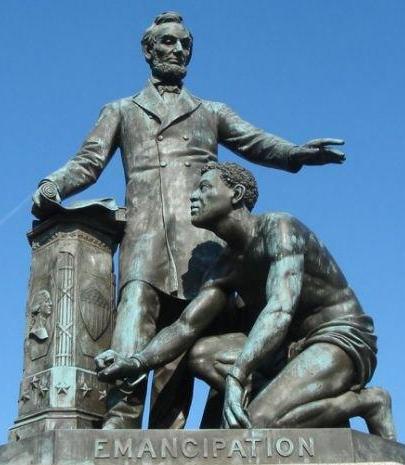
The sculpture (sometimes mocked as the “shoeshine memorial”) was actually controversial from the beginning because of this. Frederick Douglass, although he spoke at the Memorial’s dedication, wrote a letter to the editor of the National Republican to complain that the black man was “still on his knees and nude” and said, “What I want to see before I die is a monument representing the negro, not couchant on his knees like a four-footed animal, but erect on his feet like a man.” (The Boston copy of the sculpture was removed from Park Square in December of 2021). Lewis’ sculpture doesn’t quite fulfill Douglass’ wish, since it was not designed as a public monument–although he knew her and might even have had her piece in mind when he wrote his letter to the editor. But she did break with this tradition of the supplicant Black figure by showing the freed man standing tall, even if still looking up at a higher power, however defined. That said, though, her female figure is kneeling, which seems to go against the idea that she is altogether free; instead, she seems to be dependent on the man, whose hand on her shoulder seems to suggest that she needs his protection.
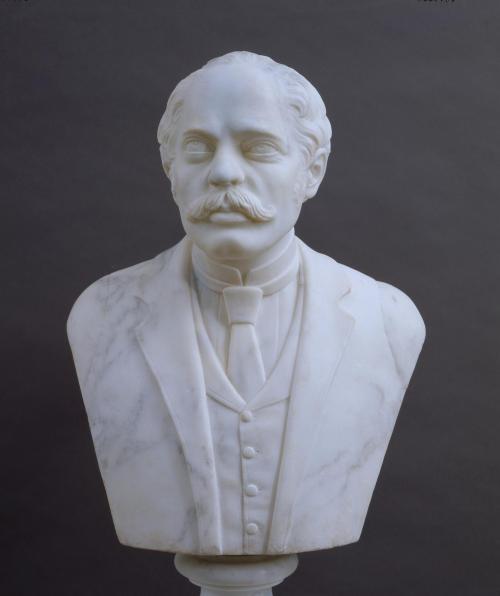
What is also unusual, at least for Lewis herself, is that she gives the man features that are supposed to signal his Blackness–even though again, that seems logical if the sculpture is supposed to represent a freed American man of African descent. But the only other known sculpture by Lewis that shows a man with African-American features is a portrait bust of James Peck Thomas, a wealthy Black businessman who commissioned the sculpture from Lewis when he visited her studio in 1873. Even more importantly, she never gave any female figure in her known work ethnic features (although she presumably did so in her now-lost bronze bust of the 18th-century Black poet Phillis Wheatley for the World’s Columbian Exhibition of 1893).
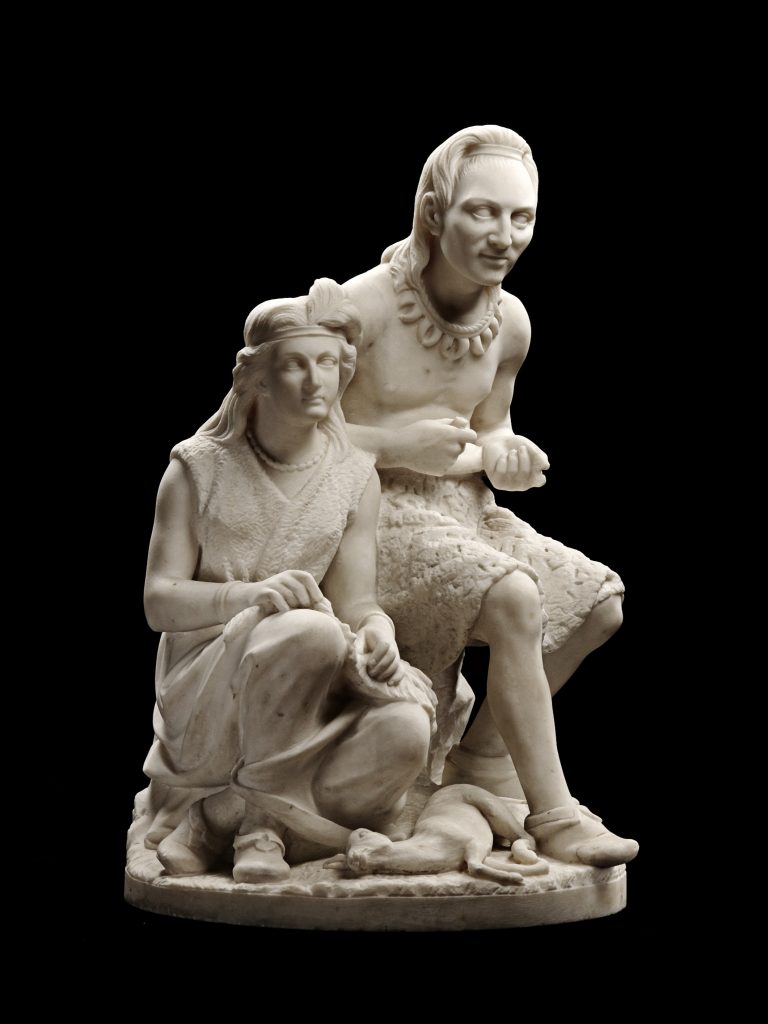
Lewis’ choice to make the figure of the woman in Forever Free have a generic “neoclassical white female” look is a pattern that is also typical for her Native American-themed sculptures inspired by Longfellow, like The Old Arrowmaker (1868), in which the father has features that signal his “Indianness,” but his daughter, Minnehaha, does not–although her Native American clothing and the feather in her hairband suggest her ethnicity. She also has the “Greek” face that was associated with ideal female beauty in neoclassical sculpture. And this kind of ideal face was associated with the whiteness not just of marble but of a pale, “European” complexion. In addition to making her freed woman in Forever Free look generically and neoclassically white, Lewis also opted to keep her clothed, even as the male in the sculpture is represented as half-naked, and in that respect, she makes another conventional, if not especially conservative choice–“chaste nudes” were considered appropriate, unobjectionalbe “high art” in many context in 19th-century sculpture, but Lewis did not tend do go there. (More on both the question of whiteness and nude female figures in Lewis and Neoclassicism.)
So, to sum up, in Forever Free, Lewis creates a female figure who kneels as opposed to standing up by the man’s side, is not represented as “Black,” and is fully and chastely dressed. That seems frustratingly conservative for a sculptor whose life and career make her such a trailblazer, both as a female artist and as an artist of color. Even if it was innovative or daring by showing the male figure standing upright, the female figure does seem to walk all of that back. And this is where art historians that have written about Forever Free (see Resources) have really helped me understand how cultural context can add more nuance to the way I see this sculpture.
For one thing, it is important to remember that even in making Forever Free, Lewis was not exactly free in what she was creating, since she was economically dependent on selling her work. She needed to pay attention to what her patrons would buy, and even in the most progressive circles, women’s inferior position with regard to men was often taken for granted. Behind it lay an entire ideology of “natural” difference between men and women at the time that would have been hard to get away from. Even in 1916, 50 years later, Meta Vaux Fuller could still write that this sculpture shows that “The man accepts [freedom] as a glorious victory, while the woman looks upon it as a precious gift” (quoted in Murray, 225). This is still the language of “natural” difference between the way men and women see the world. It’s impossible to find out whether Lewis herself approved of this ideology, but we do know that she was very adept at figuring out how to market herself to potential buyers of her art, and not push the envelope too far, both stylistically and thematically. Consciously following the conventions is definitely a partial way to explain the way the woman is represented.
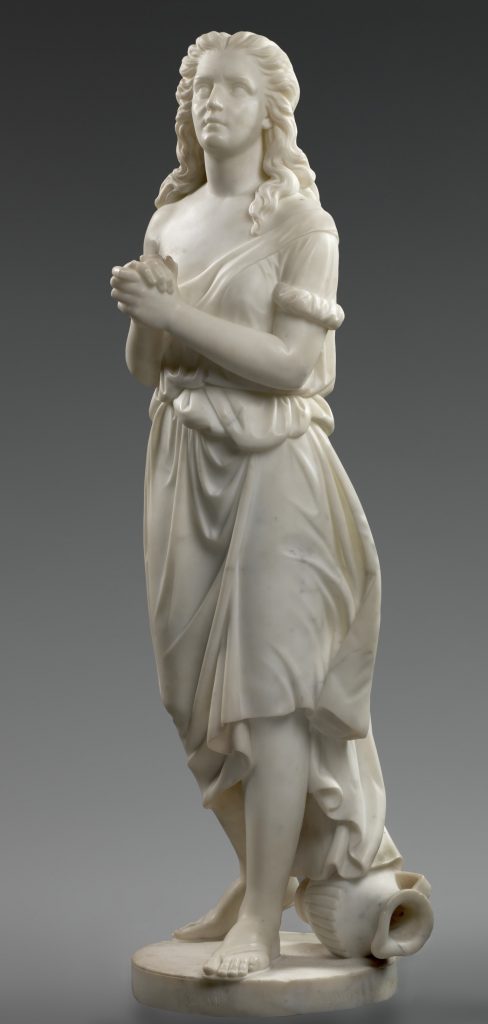
In addition, Lewis was always intent on avoiding evoking negative stereotypes about Black women, and it is very likely that this influenced her choice to show the female figure as submissive, to give her “ethnic” features, and to avoid any kind of nudity. It can’t be emphasized enough that anything that drew attention to a Black woman’s ethnic features or her body could sexualize that woman and reduce her, in the eyes of viewers, to a savage and an animal. These kinds of racist stereotypes were so powerful and so pervasive that even a woman who stood in for a Black woman, like Lewis’ Hagar (right) or her Cleopatra, needed to be rendered as “white” and as devoid of sexuality as possible. If Lewis wanted her freedwoman to be unambiguously positive and to be exempt from any taint of the erotic, she had to make her recognizable at first glance as the chaste, pious, and submissive wife associated with Victorian ideals of womanhood and also with the Christian iconography of the Madonna. (It makes sense in this context that an earlier version of her emancipation sculpture, now lost, was described by several visitors to her studio as showing a freedwoman with her child.)
But there may be another reason that make Lewis seem less oppressively dependent on creating work that was sellable and “proper”–a reason that comes back around, at least partially, to the empowering way in which the upright, newly freed Black man is represented. She is showing a formerly enslaved man and woman with a strong suggestion that they are a couple (the female does not look young enough to be the man’s daughter; their identical broken shackles suggests the connection as well). If unequal pose actually suggests that they are an ordinary couple–that they are part of the standard gender hierarchy of the time, in which he is her protector–that in itself is a sign of freedom. In slavery, the man would not have been able to protect the woman–both of them would have been equally at the mercy of their white owners. Their marriage would not have been legal; the threat of being separated and sold off to a different plantation was constant (and in fact, one of the most powerful arguments the abolitionists in their attempt to recruit supporters for the cause of emancipation). And now, the sculpture suggests, as the result of emancipation, a Black man can protect his female partner. In fact, because of the Emancipation Proclamation, enforced by the outcome of the Civil War, he is no longer beholden to the white abolitionist supporters that were necessary to get the political support of an all-white government for emancipation and enforce the abolition of slavery.
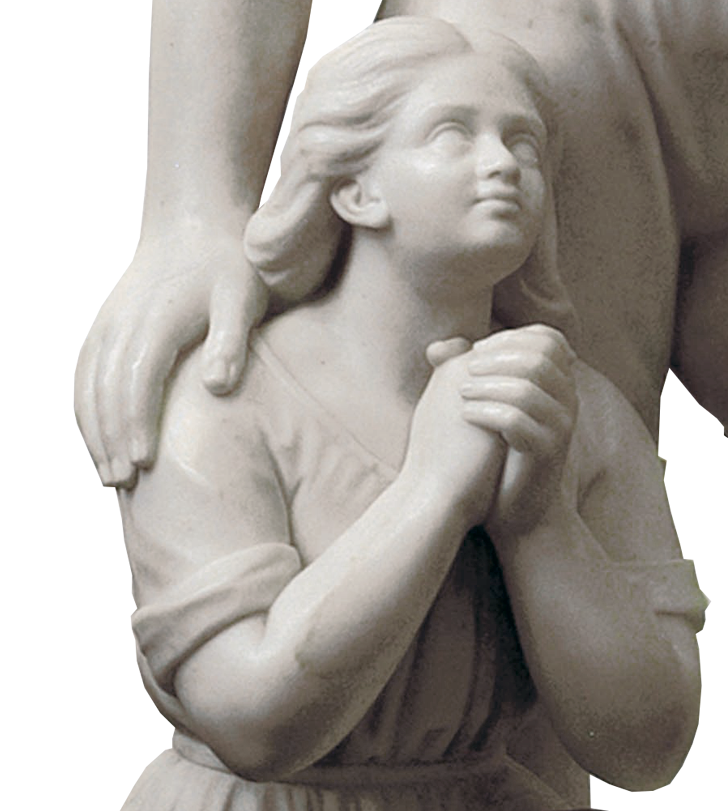
This may be too optimistic an interpretation of the sculpture–and of course it doesn’t make the gender imbalance go away; it just makes clear how complicated things get at the intersection of gender and race. But it gave me a better sense of why Lewis might have drawn on the most conservative conventions of her society about gender and also of neoclassical style, and how she might have used that very conservatism subversively to celebrate one of the most promising moments of the long and often disheartening 19th-century struggle for Black equality and civil rights in the US.
Your Turn
Assuming that you looked at the large image of Forever Free before you read the essay about it, have another look at the full-length sculpture. Are you seeing anything new or different? What do you see that you think this essay does not address, or doesn’t address in sufficient detail?
If you also checked out the post on Lewis’ Death of Cleopatra, as yourself what works better for you: An essay “explaining” the sculpture like this, or a short video doing the same kind of thing?
I see the female figure as a very young girl given how short her arms are and not his spouse. she is grateful to be free with her hands in a prayful position. the male is her protector not a mate and it doesn’t appear a sexual relationship.
That’s a really interesting point, Joanna. I agree she looks young, but if I compare her with other female figures that are supposed to be young adult females, like Minnehaha in her Native American sculptures based on Longfellow’s poem “Hiawatha,” they follow a similar pattern. And the sculptural style at the time tended to represent almost all young women asexual–Lewis always did; her “Cleopatra” is the only exception. So I would tend to agree with the art historians I’ve read that they are supposed to be a (young) couple. I do have to admit, though, that I would have to go back and look at the descriptions in the newspapers of the 1860s to confirm that viewers at the time saw a couple, not, say, father and daughter.
Without knowing anything about the artist or the background of the work Forever Free, I saw it as a piece done by an unsophisticated artist, without classical training. There is nothing about the gestures or anatomical detail to suggest that the artist was observing actual people, and certainly not Black people. Other than the man’s curly hair, there is nothing about the features of either that suggests that they are Black. I am sympathetic to Lewis’ mission in doing the piece, with the recognition that it is historically important, but it is not a of a sculptural quality that should be in an art museum.
Thanks for your comment, Karen. The blog post about “Forever Free” tries to explain in some detail why Lewis (and, by the way, also other 19th-century sculptors, as per the conventions of the time) often represented Black subjects in ways that do not look Black to us as viewers at all, and why LEwis deliberately made her female figures of color look white. Maybe I wasn’t as clear as I hoped to be? Or maybe the post was too long 😊 I would be curious whether it sheds light for you on her reasons for not being more realistic–you are right she does not work from nature, but academic training (especially for women at the time) was actually surprisingly limited in terms of what it considered as “from observation.” As far as that training is concerned, at this time in the mid-1860s, Lewis was in fact still fairly inexperienced in her profession and getting more instruction and practice as she established herself in Rome in her mid-20s. The commentary at the time shows that some of the people who saw her art would have agreed with you that she was not quite “there” yet. She would have had little opportunity to work from live models in Boston before her years in Rome. I have also wondered whether she had a tendency to deviate from classical proportions because she herself was quite short (perhaps as short as 4 feet, as it says in her passport documents!); many of her figures strike me as a bit “quashed.” Ultimately, though, the sculpture is important because it is historically unique as an early emancipation-themed work by a Black (and female!) sculptor—-I know you don’t think that is enough to warrant “art museum status” but to me, it is. So I am pleased it is currently part of an emancipation exhibit at the Met (Feb-March 2023), and I wish I could go!
First, thank you for this explanation. I’m here because of Edmonia Lewis’s Forever stamp. I bought a sheet and wanted to find out who she was. I was delighted and floored that she was a female artist, a sculptor no less! Seeing a photo of Forever Free is certainly not the best way to view a work of art, so I was glad you could flesh out the details. I had a lot of thoughts: a daughter of mixed race might account for such a stark “white” girl look. I definitely did not get wife vibes. But I love hearing everyone’s thoughts about her mysterious identity and the historical context in which she was created. I truly feel that we can in no way underestimate the pervasive thought across culture, race and class that women are inferior to men and the laws that reinforce this notion to this day. So with that backdrop whoever this woman/girl is she does need protection and it is a small victory that she is there at all. To me what is so incredible about this work is that Ms. Lewis was able to create it! That she had the means to go to Rome and further her study, that she was able to sell her work, that she survived a brutal attack by white men and continued to work. Whatever this work might lack in sophisticated technique it is a testament to the victory of the artist herself and the Emancipation Proclamation. I always want to know the context in which a work of art was created and I feel sad that the details of Edmonia’s thoughts and feelings are lost to time.
Thank you so much! I am so glad the stamp has brought several curious purchasers to this site. I would tend to agree with you that the woman Lewis depicted would certainly be thought of as “mixed race” and she sure looks young enough (and small enough) to be a daughter; but the literature always describes the two as man and wife, and some of Lewis’ other sculptures of young women also make them look almost like children. I think that was partly a strategy to make sure that white viewers and patrons would empathize–the abolitionists Lewis knew in Boston often used light-skinned, white-presenting girls and women to make their case against the abuses of slavery, and she might have followed their lead, even as we would think of that entire line of argument as very problematic. I would agree that the big deal about this sculpture–and all of Lewis’ work–is that it came into existence and that quite a bit of it has survived–but I also share your sadness that we do not have more records and writings by her. But here research is ongoing (I just recently met a Ph.D. student who is working on Lewis) and perhaps some things will still turn up in Italy!